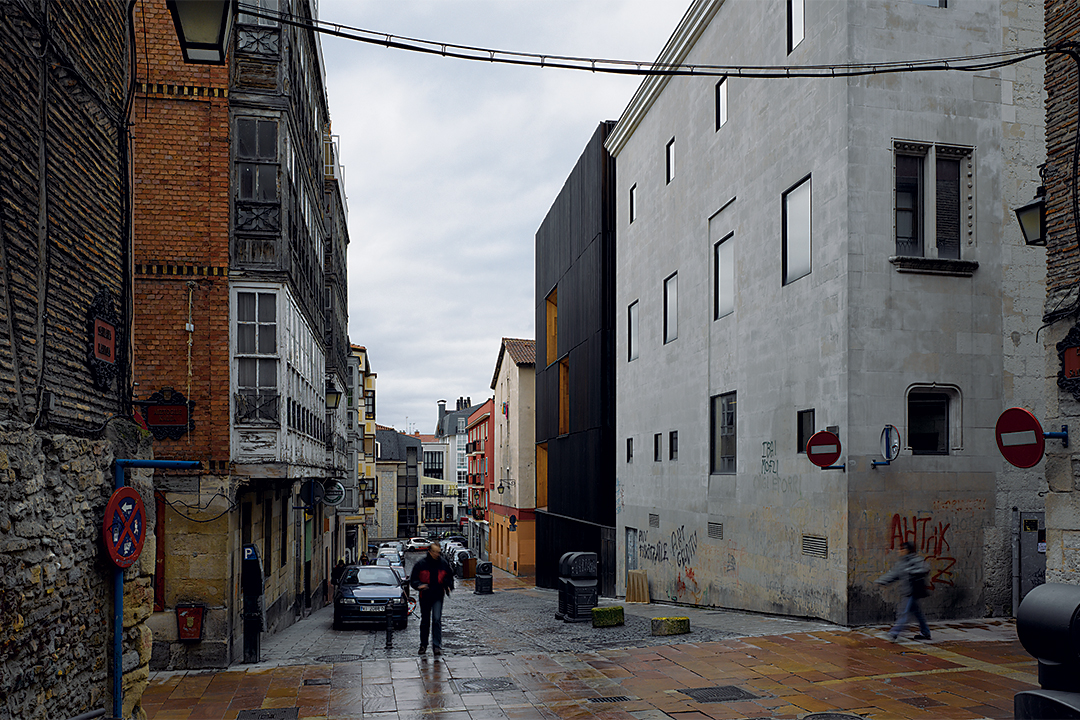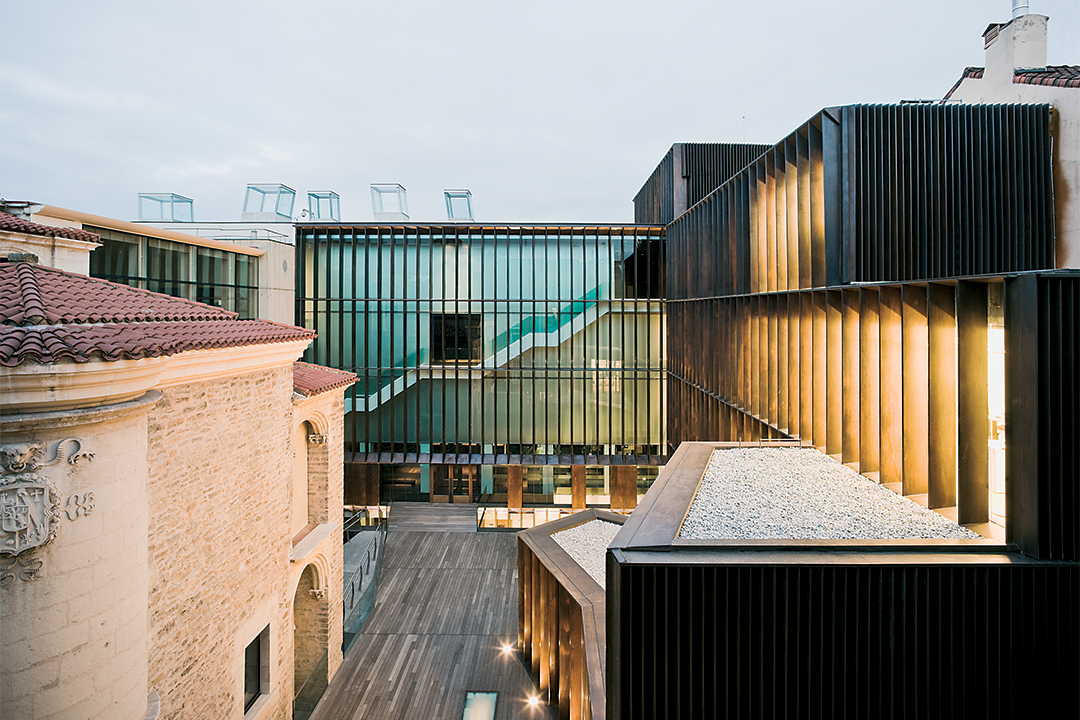After a competition in 2000 and completion in 2009, the Archaeological Museum of Álava is the first exhibition building by Francisco Mangado, a 52-year-old Spanish architect who is probably the most prolific of his generation. Author of several congress centres and auditoriums, a soccer stadium, an equestrian centre, a winery, many housing schemes, schools and swimming pools, several office buildings and corporate headquarters, public squares in Spain and in France, countless designs of urban furniture, handles or seats, as well as the Spanish Pavilion in Expo 2008, for which he recently received the Spanish prize for the best building of the last two years, Mangado has worked in such a variety of scales, programmes and situations during his 25-year career that it comes as a surprise that this should be his first museum, a type which is very prominent in the oeuvre of his contemporaries Mansilla & Tuñón or Nieto & Sobejano.
Located in the medieval core of Vitoria, the capital of the Álava province and also of the Basque Country – a northern region close to Mangado’s home town and base, Pamplona – the museum fits its compact geometry into the tight, steep street pattern of a rather jaded but preserved old city, where decay and graffiti create a grim but nonetheless appealing atmosphere. Closely interlocked with the 16th-century Palace of Bendaña, which now houses a museum of playing cards – Vitoria has a long tradition in the manufacture of card decks – the Archaeological Museum occupies the perimeter of the site with a dark and hermetic bronze-sheathed box, together with a shallow auxiliary wing that hides an unseemly party wall and leads the visitor to an entrance courtyard shared with the playing cards museum, and shaped by transparent façades that enclose the long flight of stairs of the main access, as well as other circulation spaces.
The sombre exterior, defensive in front of an abrasive environment, is in tune with the almost black exhibition rooms, where the display cabinets are embedded in the walls – the few openings to the street show the thickness of the façade in their splayed sides – and several inclined lamps of white glass pretend to bring natural light into the rooms, giving the interiors a very theatrical appearance, with luminous leaning boxes floating weightlessly in a dark scenario. This dramatic feature – shafts of light haphazardly perforating a black exhibition box – is probably responsible for Mangado’s success in the competition, but the virtues of the finished building go far beyond this cute idea, which inevitably reminds one of the performance of a stage magician driving swords into a box where an assistant has been previously locked and is finally released intact to the relief and delight of the audience. Here, the building also survives its multiple wounds, and the artificially lit white boxes that clutter the rooms at least guarantee that careless curators will not deface the interiors in the future.

The very year the museum was completed, AV Monographs published the ten most important works of Mangado in the decade 1999–2009 under ten key words (context, material, topography, economy, technique, space, programme, process, representation and nature) which summarize his approach as an architect and teacher – having completely transformed the excellent school of his home town, he has also left his mark at Harvard and Yale – and this is how I attempted to sketch the sequence of the publication: ‘the contextual and urban wisdom of the Baluarte, the materiality of bronze in the Archaeological Museum of Álava, the granitic and historical topography of the Ávila Congress Centre, the exact economy of the Gamesa Eólica headquarters, the technical search in the Training Centre of Santiago, the spatial display in Teulada’s Auditorium, the mixed programme in Palencia’s stadium, the fertile creativity of the design process in the swimming pool of Orense, the symbolic impact of representation in the Spanish Pavilion and the respect for nature and the rural context in the laconic sheds of the equestrian centre of Ultzama’. As can be seen, the bronze façade is so dominant a feature that the museum was associated with the key word material; but it might be a pedagogical exercise to assess it against each and every one of the terms.
In this vein, context would allude to the effortless way in which it fits into its urban environment, acknowledging it and at the same time sharply and diffidently showing its distance from the faint squalor of the surroundings, while courting the palace with unashamed preference.
Material inevitably refers to the bronze, an unexpectedly noble and expensive alloy whose choice conveys archaeological remains and expresses the passage of time through weathering and patina.
Topography is singularly appropriate for this urban site, whose steep profile is cleverly used to design the entry sequence in the courtyard with a bridge over a sunken garden that allows natural light into the lower levels.
Economy can be well understood in the regularity of the structure and in the compactness of the volume, bringing constructive and thermal benefits that reduce both initial cost and maintenance budget, and even in the clever design of the bronze grille, whose vertical louvres are cast at street level, but shaped with only a thin bronze sheet folded around a wood base in the rest of the building.
Technique is evident in the exquisite detailing of the façade, flat roof and skylights, from the bronze and steel sheets to the glass plate or the wooden boards, a finely honed and crafted assembly of precious or common materials.

Space is most clearly perceived in the narrowing and expanding of the entrance from the street to the access courtyard, in the dramatic cascading main staircase or in the labyrinthian metaphysical minimalism of the exhibition rooms.
Programme is idiosyncratically interpreted in this maiden museum of Mangado, with the glass cases of the exhibits incorporated into the building’s wall, therefore combining construction and fittings in a single design decision.
Process is to be found in the long search for a company that could deliver bronze sheet – after the cast bronze initially considered proved unaffordable and was limited to the lower part of the façade – finally found in Germany, importing the raw material that would later be cut and folded in local workshops.
Representation refers to the hermetic character of the box, clearly conveying its institutional nature, and only perforated on its short side by three large chequered openings which remind one of the façade of Alejandro de la Sota’s Gobierno Civil in Tarragona, with a musical rhythm and a trompe-l’oeil wink in its theatrical depth plus an equivocal play of reflections which suggest seeing through the false façade of a stage set, thereby suggesting that the building is a scenario to display a story, as well as a jewel box for the protection of valuable objects, in the end exhibiting and storing, as befits a museum.
And nature, inevitably associated in this urban site with the material and its life-cycle, so that the weathering of the bronze brings this magic box, which Kenneth Frampton has described as a boîte à miracles, into the realm of decay that befalls all things natural, thus defeating human efforts to preserve the archaeological past in an ageless strongbox, in the end dragged by the swift current of time, like us all.